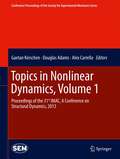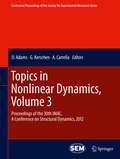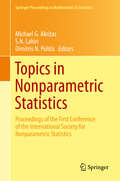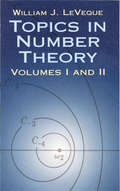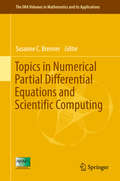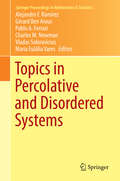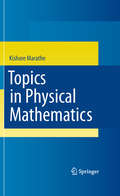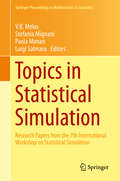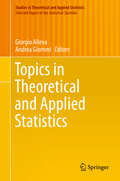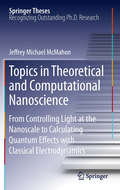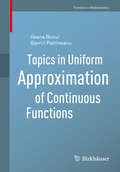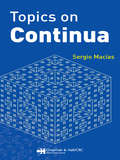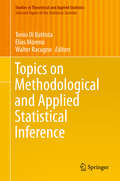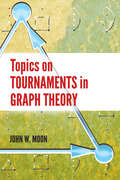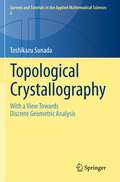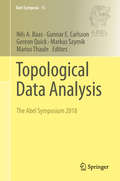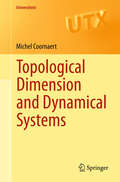- Table View
- List View
Topics in Nonlinear Dynamics, Volume 1
by Douglas Adams Alex Carrella Gaetan KerschenTopics in Nonlinear Dynamics, Volume 1: Proceedings of the 31st IMAC, A Conference and Exposition on Structural Dynamics, 2013, the first volume of seven from the Conference, brings together contributions to this important area of research and engineering. The collection presents early findings and case studies on fundamental and applied aspects of Structural Dynamics, including papers on: Nonlinear Oscillations Nonlinearities ... In Practice Nonlinear System Identification: Methods Nonlinear System Identification: Friction & Contact Nonlinear Modal Analysis Nonlinear Modeling & Simulation Nonlinear Vibration Absorbers Constructive Utilization of Nonlinearity
Topics in Nonlinear Dynamics, Volume 3
by G. Kerschen A. Carrella D. AdamsTopics in Nonlinear Dynamics, Volume 3, Proceedings of the 30th IMAC, A Conference and Exposition on Structural Dynamics, 2012, the third volume of six from the Conference, brings together 26 contributions to this important area of research and engineering. The collection presents early findings and case studies on fundamental and applied aspects of Structural Dynamics, including papers on: Application of Nonlinearities: Aerospace Structures Nonlinear Dynamics Effects Under Shock Loading Application of Nonlinearities: Vibration Reduction Nonlinear Dynamics: Testing Nonlinear Dynamics: Simulation Nonlinear Dynamics: Identification Nonlinear Dynamics: Localization
Topics in Nonparametric Statistics
by Dimitris N. Politis Michael G. Akritas S. N. LahiriThis volume is composed of peer-reviewed papers that have developed from the First Conference of the International Society for Non Parametric Statistics (ISNPS). This inaugural conference took place in Chalkidiki, Greece, June 15-19, 2012. It was organized with the co-sponsorship of the IMS, the ISI and other organizations. M. G. Akritas, S. N. Lahiri and D. N. Politis are the first executive committee members of ISNPS and the editors of this volume. ISNPS has a distinguished Advisory Committee that includes Professors R. Beran, P. Bickel, R. Carroll, D. Cook, P. Hall, R. Johnson, B. Lindsay, E. Parzen, P. Robinson, M. Rosenblatt, G. Roussas, T. SubbaRao and G. Wahba. The Charting Committee of ISNPS consists of more than 50 prominent researchers from all over the world. The chapters in this volume bring forth recent advances and trends in several areas of nonparametric statistics. In this way, the volume facilitates the exchange of research ideas, promotes collaboration among researchers from all over the world and contributes to the further development of the field. The conference program included over 250 talks, including special invited talks, plenary talks and contributed talks on all areas of nonparametric statistics. Out of these talks, some of the most pertinent ones have been refereed and developed into chapters that share both research and developments in the field.
Topics in Number Theory, Volumes I and II
by William J. LevequeClassic two-part work now available in a single volume assumes no prior theoretical knowledge on reader's part and develops the subject fully. Volume I is a suitable first course text for advanced undergraduate and beginning graduate students. Volume II requires a much higher level of mathematical maturity, including a working knowledge of the theory of analytic functions. Contents range from chapters on binary quadratic forms to the Thue-Siegel-Roth Theorem and the Prime Number Theorem. Includes numerous problems and hints for their solutions. 1956 edition. Supplementary Reading. List of Symbols. Index.
Topics in Numerical Partial Differential Equations and Scientific Computing
by Susanne C. BrennerNumerical partial differential equations (PDEs) are an important part of numerical simulation, the third component of the modern methodology for science and engineering, besides the traditional theory and experiment. This volume contains papers that originated with the collaborative research of the teams that participated in the IMA Workshop for Women in Applied Mathematics: Numerical Partial Differential Equations and Scientific Computing in August 2014.
Topics in Percolative and Disordered Systems
by Charles M. Newman Alejandro F. Ramírez Gérard Ben Arous Pablo A. Ferrari Vladas Sidoravicius Maria Eulália VaresThis volume features selected and peer-reviewed articles from the Pan-American Advanced Studies Institute (PASI). The chapters are written by international specialists who participated in the conference. Topics include developments based on breakthroughs in the mathematical understanding of phenomena describing systems in highly inhomogeneous and disordered media, including the KPZ universality class (describing the evolution of interfaces in two dimensions), random walks in random environment and percolative systems. PASI fosters a collaboration between North American and Latin American researchers and students. The conference that inspired this volume took place in January 2012 in both Santiago de Chile and Buenos Aires. Researchers and graduate students will find timely research in probability theory, statistical physics and related disciplines.
Topics in Physical Mathematics
by Kishore MaratheAs many readers will know, the 20th century was a time when the fields of mathematics and the sciences were seen as two separate entities. Caused by the rapid growth of the physical sciences and an increasing abstraction in mathematical research, each party, physicists and mathematicians alike, suffered a misconception; not only of the opposition's theoretical underpinning, but of how the two subjects could be intertwined and effectively utilized. One sub-discipline that played a part in the union of the two subjects is Theoretical Physics. Breaking it down further came the fundamental theories, Relativity and Quantum theory, and later on Yang-Mills theory. Other areas to emerge in this area are those derived from the works of Donaldson, Chern-Simons, Floer-Fukaya, and Seiberg-Witten. Aimed at a wide audience, Physical Topics in Mathematics demonstrates how various physical theories have played a crucial role in the developments of Mathematics and in particular, Geometric Topology. Issues are studied in great detail, and the book steadfastly covers the background of both Mathematics and Theoretical Physics in an effort to bring the reader to a deeper understanding of their interaction. Whilst the world of Theoretical Physics and Mathematics is boundless; it is not the intention of this book to cover its enormity. Instead, it seeks to lead the reader through the world of Physical Mathematics; leaving them with a choice of which realm they wish to visit next.
Topics in Quaternion Linear Algebra (Princeton Series in Applied Mathematics #45)
by Leiba RodmanQuaternions are a number system that has become increasingly useful for representing the rotations of objects in three-dimensional space and has important applications in theoretical and applied mathematics, physics, computer science, and engineering. This is the first book to provide a systematic, accessible, and self-contained exposition of quaternion linear algebra. It features previously unpublished research results with complete proofs and many open problems at various levels, as well as more than 200 exercises to facilitate use by students and instructors. Applications presented in the book include numerical ranges, invariant semidefinite subspaces, differential equations with symmetries, and matrix equations.Designed for researchers and students across a variety of disciplines, the book can be read by anyone with a background in linear algebra, rudimentary complex analysis, and some multivariable calculus. Instructors will find it useful as a complementary text for undergraduate linear algebra courses or as a basis for a graduate course in linear algebra. The open problems can serve as research projects for undergraduates, topics for graduate students, or problems to be tackled by professional research mathematicians. The book is also an invaluable reference tool for researchers in fields where techniques based on quaternion analysis are used.
Topics in Statistical Simulation
by Luigi Salmaso Stefania Mignani V. B. Melas Paola MonariThe Department of Statistical Sciences of the University of Bologna in collaboration with the Department of Management and Engineering of the University of Padova, the Department of Statistical Modelling of Saint Petersburg State University, and INFORMS Simulation Society sponsored the Seventh Workshop on Simulation. This international conference was devoted to statistical techniques in stochastic simulation, data collection, analysis of scientific experiments, and studies representing broad areas of interest. The previous workshops took place in St. Petersburg, Russia in 1994, 1996, 1998, 2001, 2005, and 2009. The Seventh Workshop took place in the Rimini Campus of the University of Bologna, which is in Rimini's historical center.
Topics in Structural Graph Theory
by Lowell W. Beineke Robin J. WilsonThe rapidly expanding area of structural graph theory uses ideas of connectivity to explore various aspects of graph theory and vice versa. It has links with other areas of mathematics, such as design theory and is increasingly used in such areas as computer networks where connectivity algorithms are an important feature. Although other books cover parts of this material, none has a similarly wide scope. Ortrud R. Oellermann (Winnipeg), internationally recognised for her substantial contributions to structural graph theory, acted as academic consultant for this volume, helping shape its coverage of key topics. The result is a collection of thirteen expository chapters, each written by acknowledged experts. These contributions have been carefully edited to enhance readability and to standardise the chapter structure, terminology and notation throughout. An introductory chapter details the background material in graph theory and network flows and each chapter concludes with an extensive list of references.
Topics in Theoretical Computer Science: Third IFIP WG 1.8 International Conference, TTCS 2020, Tehran, Iran, July 1–2, 2020, Proceedings (Lecture Notes in Computer Science #12281)
by Luís S. Barbosa Mohammad Ali AbamThis book constitutes the refereed proceedings of the Third IFIP WG 1.8 International Conference on Topics in Theoretical Computer Science, TTCS 2020, held in Tehran, Iran, in July 2020. The conference was held virtually due to the COVID-19 pandemic. The 8 papers presented in this volume were carefully reviewed and selected from 24 submissions. They focus on novel and high-quality research in all areas of theoretical computer science, such as algorithms and complexity; logic, semantics, and programming theory; and more.
Topics in Theoretical and Applied Statistics
by Giorgio Alleva Andrea GiommiThis bookhighlights the latest research findings from the 46th International Meeting ofthe Italian Statistical Society (SIS) in Rome, during which both methodologicaland applied statistical research was discussed. This selection of fullypeer-reviewed papers, originally presented at the meeting, addresses a broadrange of topics, including the theory of statistical inference; data mining andmultivariate statistical analysis; survey methodologies; analysis of social,demographic and health data; and economic statistics and econometrics.
Topics in Theoretical and Computational Nanoscience
by Jeffrey Michael McmahonInterest in structures with nanometer-length features has significantly increased as experimental techniques for their fabrication have become possible. The study of phenomena in this area is termed nanoscience, and is a research focus of chemists, pure and applied physics, electrical engineers, and others. The reason for such a focus is the wide range of novel effects that exist at this scale, both of fundamental and practical interest, which often arise from the interaction between metallic nanostructures and light, and range from large electromagnetic field enhancements to extraordinary optical transmission of light through arrays of subwavelength holes. This dissertation is aimed at addressing some of the most fundamental and outstanding questions in nanoscience from a theoretical and computational perspective, specifically: · At the single nanoparticle level, how well do experimental and classical electrodynamics agree? · What is the detailed relationship between optical response and nanoparticle morphology, composition, and environment? · Does an optimal nanostructure exist for generating large electromagnetic field enhancements, and is there a fundamental limit to this? · Can nanostructures be used to control light, such as confining it, or causing fundamentally different scattering phenomena to interact, such as electromagnetic surface modes and diffraction effects? · Is it possible to calculate quantum effects using classical electrodynamics, and if so, how do they affect optical properties?
Topics in Topological Graph Theory
by Thomas W. Tucker Lowell W. Beineke Robin J. Wilson Jonathan L. GrossThe use of topological ideas to explore various aspects of graph theory, and vice versa, is a fruitful area of research. There are links with other areas of mathematics, such as design theory and geometry, and increasingly with such areas as computer networks where symmetry is an important feature. Other books cover portions of the material here, but there are no other books with such a wide scope. This book contains fifteen expository chapters written by acknowledged international experts in the field. Their well-written contributions have been carefully edited to enhance readability and to standardize the chapter structure, terminology and notation throughout the book. To help the reader, there is an extensive introductory chapter that covers the basic background material in graph theory and the topology of surfaces. Each chapter concludes with an extensive list of references.
Topics in Uniform Approximation of Continuous Functions (Frontiers in Mathematics)
by Ileana Bucur Gavriil PaltineanuThis book presents the evolution of uniform approximations of continuous functions. Starting from the simple case of a real continuous function defined on a closed real interval, i.e., the Weierstrass approximation theorems, it proceeds up to the abstract case of approximation theorems in a locally convex lattice of (M) type. The most important generalizations of Weierstrass’ theorems obtained by Korovkin, Bohman, Stone, Bishop, and Von Neumann are also included.In turn, the book presents the approximation of continuous functions defined on a locally compact space (the functions from a weighted space) and that of continuous differentiable functions defined on ¡n. In closing, it highlights selected approximation theorems in locally convex lattices of (M) type.The book is intended for advanced and graduate students of mathematics, and can also serve as a resource for researchers in the field of the theory of functions.
Topics on Combinatorial Semigroups
by Yun Liu Yuqi Guo Shoufeng WangBy combinatorial semigroups, we mean a general term of concepts, facts and methods which are produced in investigating of algebraic and combinatorial properties, constructions, classifications and interrelations of formal languages and automata, codes, finite and infinite words by using semigroup theory and combinatorial analysis. The main research objects in this field are the elements and subsets of the free semigroups and monoids and many combinatorial properties of these objects, which are closely related to algebraic theory of semigroups. This book first introduces some basic concepts and notations in combinatorial semigroups. Since many contents involving the constructions of (generalized) disjunctive languages and regular languages are closely related to the algebraic theory of codes, some selected topics are introduced in the following chapter, including the method of defining codes by using dependence systems, the maximality and completeness of codes, and the detailed discussion of some special kinds of codes such as convex codes, semaphore codes and solid codes. Then the remaining chapters present the main topics of the book - regular languages, disjunctive languages, and their various kinds of generalizations.This book might be useful to researchers in mathematics who are interested in combinatorial semigroups.
Topics on Continua
by Sergio MaciasSpecialized as it might be, continuum theory is one of the most intriguing areas in mathematics. However, despite being popular journal fare, few books have thoroughly explored this interesting aspect of topology. In Topics on Continua, Sergio Macias, one of the field's leading scholars, presents four of his favorite continuum topics: inv
Topics on Continua
by Sergio MacíasThis book is a significant companion text to the existing literature on continuum theory. It opens with background information of continuum theory, so often missing from the preceding publications, and then explores the following topics: inverse limits, the Jones set function T, homogenous continua, and n-fold hyperspaces. In this new edition of the book, the author builds on the aforementioned topics, including the unprecedented presentation of n-fold hyperspace suspensions and induced maps on n-fold hyperspaces. The first edition of the book has had a remarkable impact on the continuum theory community. After twelve years, this updated version will also prove to be an excellent resource within the field of topology.
Topics on Methodological and Applied Statistical Inference
by Tonio Battista Elías Moreno Walter RacugnoThis book brings together selected peer-reviewed contributions from various research fields in statistics, and highlights the diverse approaches and analyses related to real-life phenomena. Major topics covered in this volume include, but are not limited to, bayesian inference, likelihood approach, pseudo-likelihoods, regression, time series, and data analysis as well as applications in the life and social sciences. The software packages used in the papers are made available by the authors. This book is a result of the 47th Scientific Meeting of the Italian Statistical Society, held at the University of Cagliari, Italy, in 2014.
Topics on Tournaments in Graph Theory (Dover Books on Mathematics)
by John W. MoonTournaments, in this context, are directed graphs - an important and interesting topic in graph theory. This concise volume collects a substantial amount of information on tournaments from throughout the mathematical literature. Suitable for advanced undergraduate students of mathematics, the straightforward treatment requires a basic familiarity with finite mathematics. The fundamental definitions and results appear in the earlier sections, and most of the later sections can be read independently of each other. Subjects include irreducible and strong tournaments, cycles and strong subtournaments of a tournament, the distribution of 3-cycles in a tournament, transitive tournaments, sets of consistent arcs in a tournament, the diameter of a tournament, and the powers of tournament matrices. Additional topics include scheduling a tournament and ranking the participants, universal tournaments, the use of oriented graphs and score vectors, and many other subjects.
Topoi: The Categorial Analysis of Logic
by Robert GoldblattA classic introduction to mathematical logic from the perspective of category theory, this text is suitable for advanced undergraduates and graduate students and accessible to both philosophically and mathematically oriented readers. Its approach moves always from the particular to the general, following through the steps of the abstraction process until the abstract concept emerges naturally.Beginning with a survey of set theory and its role in mathematics, the text proceeds to definitions and examples of categories and explains the use of arrows in place of set-membership. The introduction to topos structure covers topos logic, algebra of subobjects, and intuitionism and its logic, advancing to the concept of functors, set concepts and validity, and elementary truth. Explorations of categorial set theory, local truth, and adjointness and quantifiers conclude with a study of logical geometry.
Topological Crystallography
by Toshikazu SunadaGeometry in ancient Greece is said to have originated in the curiosity of mathematicians about the shapes of crystals, with that curiosity culminating in the classification of regular convex polyhedra addressed in the final volume of Euclid's Elements. Since then, geometry has taken its own path and the study of crystals has not been a central theme in mathematics, with the exception of Kepler's work on snowflakes. Only in the nineteenth century did mathematics begin to play a role in crystallography as group theory came to be applied to the morphology of crystals. This monograph follows the Greek tradition in seeking beautiful shapes such as regular convex polyhedra. The primary aim is to convey to the reader how algebraic topology is effectively used to explore the rich world of crystal structures. Graph theory, homology theory, and the theory of covering maps are employed to introduce the notion of the topological crystal which retains, in the abstract, all the information on the connectivity of atoms in the crystal. For that reason the title Topological Crystallography has been chosen. Topological crystals can be described as "living in the logical world, not in space," leading to the question of how to place or realize them "canonically" in space. Proposed here is the notion of standard realizations of topological crystals in space, including as typical examples the crystal structures of diamond and lonsdaleite. A mathematical view of the standard realizations is also provided by relating them to asymptotic behaviors of random walks and harmonic maps. Furthermore, it can be seen that a discrete analogue of algebraic geometry is linked to the standard realizations. Applications of the discussions in this volume include not only a systematic enumeration of crystal structures, an area of considerable scientific interest for many years, but also the architectural design of lightweight rigid structures. The reader therefore can see the agreement of theory and practice.
Topological Data Analysis: The Abel Symposium 2018 (Abel Symposia #15)
by Markus Szymik Nils A. Baas Gunnar E. Carlsson Gereon Quick Marius ThauleThis book gathers the proceedings of the 2018 Abel Symposium, which was held in Geiranger, Norway, on June 4-8, 2018. The symposium offered an overview of the emerging field of "Topological Data Analysis". This volume presents papers on various research directions, notably including applications in neuroscience, materials science, cancer biology, and immune response. Providing an essential snapshot of the status quo, it represents a valuable asset for practitioners and those considering entering the field.
Topological Degree Theory and Applications (Mathematical Analysis and Applications)
by Yeol Je Cho Yu-Qing ChenSince the 1960s, many researchers have extended topological degree theory to various non-compact type nonlinear mappings, and it has become a valuable tool in nonlinear analysis. Presenting a survey of advances made in generalizations of degree theory during the past decade, this book focuses on topological degree theory in normed spaces and its ap
Topological Dimension and Dynamical Systems
by Michel CoornaertTranslated from the popular French edition, the goal of the book is to provide a self-contained introduction to mean topological dimension, an invariant of dynamical systems introduced in 1999 by Misha Gromov. The book examines how this invariant was successfully used by Elon Lindenstrauss and Benjamin Weiss to answer a long-standing open question about embeddings of minimal dynamical systems into shifts. A large number of revisions and additions have been made to the original text. Chapter 5 contains an entirely new section devoted to the Sorgenfrey line. Two chapters have also been added: Chapter 9 on amenable groups and Chapter 10 on mean topological dimension for continuous actions of countable amenable groups. These new chapters contain material that have never before appeared in textbook form. The chapter on amenable groups is based on Følner's characterization of amenability and may be read independently from the rest of the book. Although the contents of this book lead directly to several active areas of current research in mathematics and mathematical physics, the prerequisites needed for reading it remain modest; essentially some familiarities with undergraduate point-set topology and, in order to access the final two chapters, some acquaintance with basic notions in group theory. Topological Dimension and Dynamical Systems is intended for graduate students, as well as researchers interested in topology and dynamical systems. Some of the topics treated in the book directly lead to research areas that remain to be explored.
